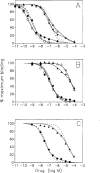Apparent heterogeneity of cardiac A1 adenosine receptors as revealed by radioligand binding experiments on N-ethylmaleimide-treated membranes
- PMID: 1775196
- PMCID: PMC5870127
- DOI: 10.1007/BF00174747
Apparent heterogeneity of cardiac A1 adenosine receptors as revealed by radioligand binding experiments on N-ethylmaleimide-treated membranes
Abstract
While G protein-coupled receptors are often studied by analyzing antagonist radioligand: "cold" agonist inhibition curves using an independent site model, it is now clear that KL and KH values determined in these analyses are not reliable estimates of the affinities of the agonists for "free" and G protein-coupled forms of the receptor. Thus, such experiments cannot be used to contrast the characteristics of a given type of receptor in different tissues, i.e., to probe for the existence of receptor subtypes. Since treatment with N-ethylmaleimide treatment blocks receptor: Gi/Go protein interactions, such analyses on N-ethylmaleimide-pretreated membranes should allow direct assessment of the affinities of competing ligands for the free receptor or for multiple receptor subtypes. As A1 adenosine receptors couple to Gi, and perhaps to Go, we have performed A1 adenosine receptor radioligand "competition" studies first on control, then on N-ethylmaleimide-pretreated bovine cardiac and cerebral cortical membranes. Results of experiments with the antagonist radioligand [3H]xanthine amine congener appeared to be confounded by ligand binding to A2 adenosine receptors present in the cardiac membrane preparations. Further experiments utilized the A1-specific radioligand [3H]1,3-dipropyl-8-cyclopentylxanthine. These experiments confirmed once more that the KL values determined by computer analysis of "competition" curves performed on control membranes are not reliable estimates of the affinities of the competing ligand for free receptors.(ABSTRACT TRUNCATED AT 250 WORDS)
Figures

Similar articles
-
Density gradient profiles of A1 adenosine receptors labeled by agonist and antagonist radioligands before and after detergent solubilization.Mol Pharmacol. 1989 Sep;36(3):412-9. Mol Pharmacol. 1989. PMID: 2506430
-
Interaction of purified bovine brain A1-adenosine receptors with guanine nucleotide-binding proteins of human platelet membranes following reconstitution.Mol Pharmacol. 1990 Aug;38(2):170-6. Mol Pharmacol. 1990. PMID: 2117248
-
Analysis of agonist-antagonist interactions at A1 adenosine receptors.Mol Pharmacol. 1990 Jul;38(1):72-83. Mol Pharmacol. 1990. PMID: 2115114 Free PMC article.
-
[3H]CGS 21680, a selective A2 adenosine receptor agonist directly labels A2 receptors in rat brain.J Pharmacol Exp Ther. 1989 Dec;251(3):888-93. J Pharmacol Exp Ther. 1989. PMID: 2600819
-
Characterization of the adenosine receptor in cultured embryonic chick atrial myocytes: coupling to modulation of contractility and adenylate cyclase activity and identification by direct radioligand binding.J Pharmacol Exp Ther. 1989 Jun;249(3):775-84. J Pharmacol Exp Ther. 1989. PMID: 2732946
Cited by
-
Transgenic A1 adenosine receptor overexpression increases myocardial resistance to ischemia.Proc Natl Acad Sci U S A. 1997 Jun 10;94(12):6541-6. doi: 10.1073/pnas.94.12.6541. Proc Natl Acad Sci U S A. 1997. PMID: 9177254 Free PMC article.
-
Regulation of adenosine receptors in cultured heart cells.Adv Exp Med Biol. 1995;382:205-15. doi: 10.1007/978-1-4615-1893-8_21. Adv Exp Med Biol. 1995. PMID: 8540397 Free PMC article.
-
Isolation and characterization of an avian A1 adenosine receptor gene and a related cDNA clone.Biochem J. 1995 May 1;307 ( Pt 3)(Pt 3):729-34. doi: 10.1042/bj3070729. Biochem J. 1995. PMID: 7741703 Free PMC article.
-
Characterization of adenosine receptors in intact cultured heart cells.Biochem Pharmacol. 1994 Aug 17;48(4):727-35. doi: 10.1016/0006-2952(94)90050-7. Biochem Pharmacol. 1994. PMID: 8080445 Free PMC article.
References
-
- Abramson SN, McGonigle P, Molinoff PB. Evaluation of models for analysis of radioligand binding data. Mol Pharmacol. 1987;31:103–111. - PubMed
-
- Asano T, Ogasawara N. Uncoupling of γ-aminobutyric acid B receptors from GTP-binding proteins by N-ethylmaleimide: Effect of ethylmaleimide on purified GTP-binding proteins. Mol Pharmacol. 1986;29:244–249. - PubMed
-
- Bradford MM. A rapid and sensitive method for the quantitation of microgram quantities of protein utilizing the principle of protein-dye binding. Anal Biochem. 1976;72:248–254. - PubMed
-
- Bruns RF, Fergus JH, Badger EW, Bristol JA, Santay LA, Hartman JD, Hays SJ, Huang CC. Binding of the A1-selective adenosine antagonist 8-cyclopentyl-l,3-dipropylxanthine to rat brain membranes. Naunyn-Schmiedeberg’s Pharmacol. 1987;335:59–63. - PubMed
Publication types
MeSH terms
Substances
Grants and funding
LinkOut - more resources
Full Text Sources
Research Materials
